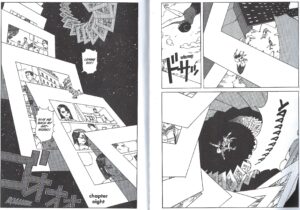The International Journal of Comic Art has just published an article of mine, “Satoshi Kon’s Opus through his Anime” (vol. 24, no. 2, Fall 2022), which means rather a lot to me. I hope you’ll pardon a bit of a digression for this one.
A decade ago, I presented a paper on the famed anime director Satoshi Kon at a regional conference of the Modern Language Assocation. Kon’s sudden death from pancreatic cancer in 2010 had shocked the anime world, and an array of tributes were produced in the immediate aftermath. By 2014, however, that wave had crested, and I was worried that Kon’s brilliant films would slowly be forgotten. So, I made one of my first conference talks as a Ph.D. student into my own small contribution to maintaining Kon’s legacy. A few months later, I presented a revised version for one of the Popular Culture Association/American Culture Association’s regional conferences. Excitingly, a member of the audience at that conference kindly invited me to contribute a chapter about to a book that he was editing. I hadn’t even earned my Ph.D., but I was already doing exactly what I had entered academia to do: help people learn about interesting, meaningful aspects of Japanese media that they wouldn’t otherwise hear about.
By the time I sat down to write my chapter, a second wave of material keeping Kon’s legacy alive had started to appear, and it included articles by more advanced scholars – in particular, Sandra Annett, whose article on nostalgic remediation in Martin Scorsese’s Hugo and Kon’s Paprika brilliantly encapsulated and extended the ideas that I had been fumbling toward in my presentations. So, I had mixed feelings when the book was delayed and ultimately cancelled due to the editor’s unfortunate illness.

I felt less of a drive to push Kon’s filmography to the forefront, but then, my work on the subject had advanced quite a bit thanks to these other scholars’ publications. I moved on from my early presentations, which had focused on the dynamic between Kon’s fascinating animation techniques, on one hand, and memory and the artistic tradition on the other. I came to focus instead upon the interplay of media within Kon’s overall oeuvre, including both the anime that made him famous but also the early manga that launched his career. While Kon’s manga had been re-issued (and translated into English) after his death, they did not spawn much in the way of scholarship.
I kept returning to my chapter on Kon over the years. My ideas further developed when I started teaching a class on anime that, naturally, featured a unit on Kon’s films. The final article synthesizes earlier scholarship on Kon’s anime by scholars like Annett, Thomas Lamarre, Melek Ortabasi, and Christopher Bolton, which I then apply to mind- and medium-bending manga called Opus. I wasn’t sure how much interest it would meet with, but John Lent, IJOCA’s editor, whipped it through review and into press with startling and impressive precision. (I can see why everyone I know who has published in IJOCA speaks so well of the process.)
All of which is to say that I am very pleased to offer up this article for your perusal. If you do look it up, please do take the time to check out the journal’s other articles. Alice fans in particular might like Mimi Okabe’s article on a Canadian publisher’s adaptation of Jane Austen’s Sense and Sensibility into a manga-style graphic novel.



